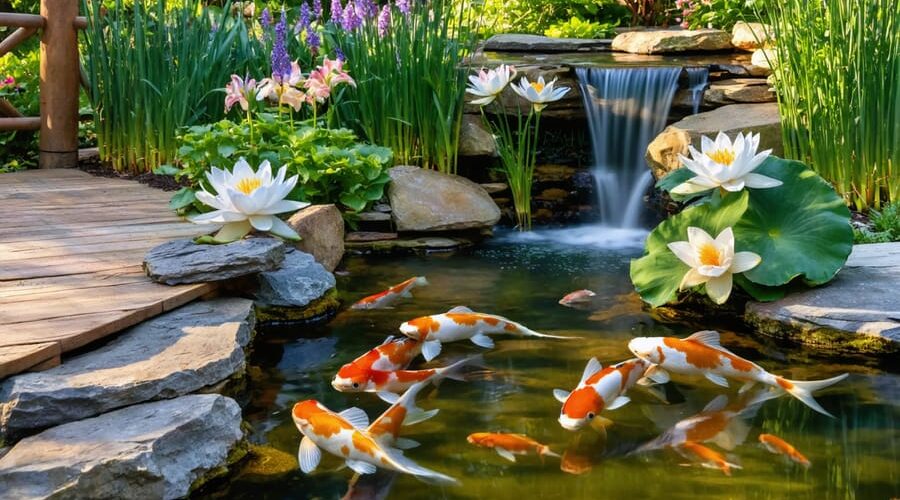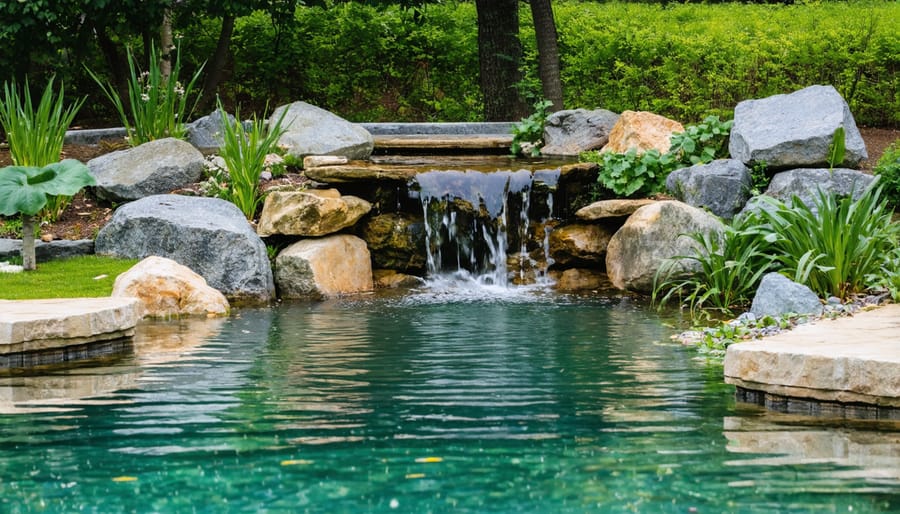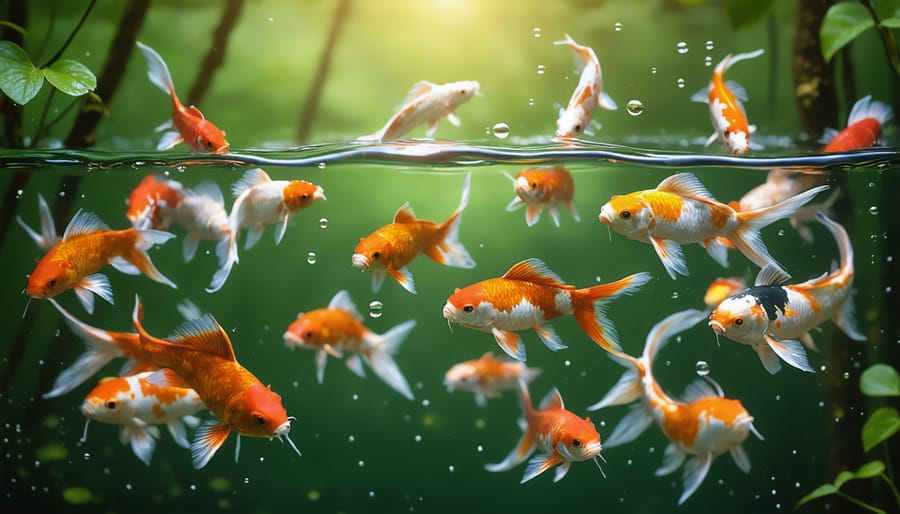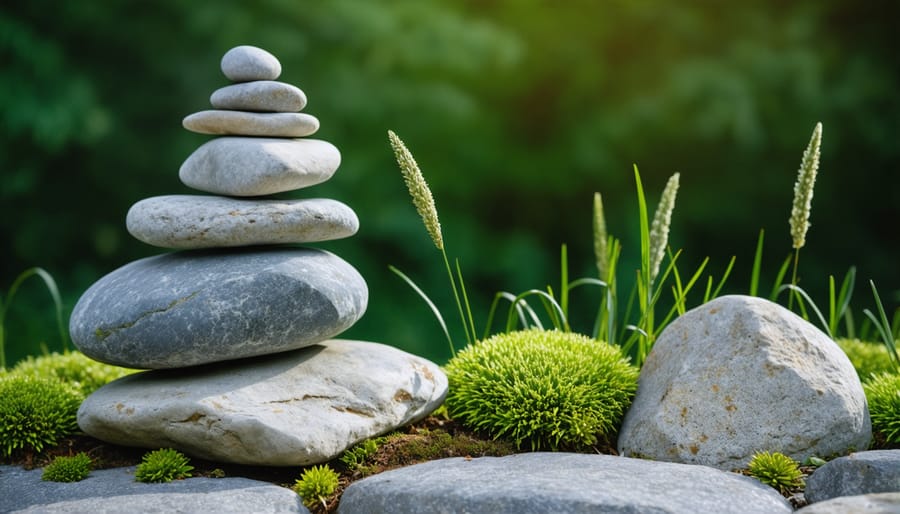
Poetry in Motion: How Artistic Design Transforms Your Backyard Pond
Transform your pond into poetry by layering depth, movement, and emotion into every design choice. Just as a poem uses carefully chosen words to evoke feeling, your water garden speaks through the interplay of stone placement, plant textures, and flowing water. The most captivating ponds aren’t just functional—they tell a story that unfolds with each season and viewing angle.
Think of your pond’s design as verses in a visual poem. The rhythm comes from repeating elements: smooth river rocks echoing around the perimeter, clusters of iris rising at intervals, or the cascading notes of a waterfall breaking the silence. Contrast creates drama—pair delicate water lilies with bold, architectural grasses, or juxtapose dark pond liner with brilliant koi. These intentional choices transform ordinary water features into a living masterpiece that resonates emotionally with everyone who encounters it.
The magic happens when you move beyond the practical checklist of pumps and filters to consider how your pond makes people *feel*. Does it invite quiet contemplation with its still, mirror-like surface? Does it energize with splashing sounds and vibrant fish? Every curve of the shoreline, every plant placement, every stone—these are your creative tools for crafting something that transcends mere landscaping and becomes art you can experience daily in your own backyard.
What Does ‘Poetry in Art’ Mean for Your Pond?

The Language of Water and Stone
Water speaks in its own language—sometimes in gentle murmurs, other times in bold declarations. Think about the last time you sat beside a bubbling stream or stood near a dramatic waterfall. That sound, that feeling—that’s the poetry happening right there in real time.
In your pond, water becomes your primary storytelling tool. A vigorous waterfall creates energy and excitement, perfect for spaces where you want movement and vitality. I learned this firsthand when I added a small cascade to my backyard pond—suddenly, the whole garden felt alive! The splashing masked neighborhood noise and drew birds like never before.
On the flip side, a still reflecting pool whispers tranquility. It invites contemplation, mirroring the sky and surrounding plants like nature’s own canvas. The mood shifts entirely based on how water moves—or doesn’t.
Stone amplifies this conversation. Smooth river rocks suggest calm flowing water, while jagged boulders create drama and texture. When you pair rushing water with rough stone, you’re composing a powerful visual poem. Gentle ripples over flat stepping stones? That’s a haiku—simple, peaceful, perfect.
Creating Emotional Connections
Your pond becomes more than just water and rocks when you design with emotion in mind. Think about how you want to feel when you approach your water feature. Do you crave a sense of calm after a hectic day? Consider incorporating smooth, rounded stones and gentle water movements that whisper rather than splash. The soft sound creates an instant relaxation response—I’ve watched countless visitors physically relax their shoulders within minutes of sitting beside my tranquil waterfall.
For joyful energy, introduce bright koi that dance through the water or playful bubbling fountains that catch sunlight. These elements spark smiles and encourage interaction, especially from children and grandchildren who visit.
Wonder comes through unexpected details: a strategically placed stepping stone that invites exploration, a hidden nook where frogs gather, or lighting that transforms your pond into a magical nighttime sanctuary. These thoughtful choices create stories and memories unique to your space.
The beauty is that your pond reflects your personality. Your emotional intentions become the invisible poetry that makes your water garden deeply personal and meaningful to everyone who experiences it.
The Building Blocks of Poetic Pond Design
Color Palette: Painting with Plants and Fish
Think of your pond as a living canvas where every color choice tells part of your story. Just like a painter selects complementary hues, you’ll want to create harmony between your koi, plants, and hardscaping elements.
Start with your koi as focal points. A striking Kohaku with bold red and white patterns becomes even more dramatic against the deep greens of water lilies and lotus. I learned this the hard way when I first added bright yellow goldfish to a pond filled with yellow irises—they simply disappeared into the background! Now I use contrasting colors: white and metallic koi pop beautifully against dark rocks and purple pickerel rush.
Consider your plant palette seasonally. Early spring whites and soft pinks from marsh marigolds can transition into summer’s vibrant blues and purples, then warm into autumn golds. Your hardscaping acts as the frame—darker stones make colors appear more vivid, while light-colored gravel creates a softer, more ethereal feel.
Don’t overthink it though. Choose three to five main colors and let them repeat throughout your design. This repetition creates visual rhythm, much like a recurring theme in a poem, guiding the eye naturally around your water garden.

Texture and Contrast: The Touch of Nature
Nature never speaks in one voice—it’s a symphony of textures that makes a pond feel alive and real. When I first started designing ponds, I made everything too uniform, and it felt flat. Then I discovered the magic of mixing materials with different textures.
Think about combining smooth, water-worn river rocks along your pond edge with rough, craggy boulders as statement pieces. The contrast between them creates visual electricity! Add soft, wispy grasses that dance in the breeze alongside rigid cattails, and suddenly you’ve got movement and stillness in conversation with each other.
Don’t forget about water plants—glossy lily pads reflect light beautifully against matte stones, while feathery underwater plants add a dreamy, mysterious quality. Mastering contrast through texture isn’t just about what you see—it’s about creating a space that begs to be touched and experienced.
Try running your hand along different materials during your design process. If everything feels the same, your eye will gloss over it. But when you create texture variety, you’re inviting visitors to really *notice* your pond’s details.
Movement and Flow: The Pond’s Rhythm
Your pond becomes truly alive when movement weaves through every layer. I’ll never forget watching my pond transform at dawn—the gentle ripple of a goldfish breaking the surface, purple iris stems swaying in the morning breeze, and water gently trickling over stones. This natural choreography creates its own water symphony that changes from sunrise to sunset.
Start by positioning your fountain or waterfall where morning light catches the spray—it’s magical! Choose plants with flexible stems like cattails or swaying grasses that dance with the slightest breeze. I always place taller specimens near the back where they can sway dramatically against the sky.
Your fish add spontaneous poetry too. Koi create mesmerizing patterns as they glide through the depths, while smaller fish dart between plant roots, creating unexpected flashes of color. Position a few flat rocks just below the surface—fish love investigating these spots, giving you constant movement to enjoy.
The beauty is that this living artwork never repeats itself. Each moment brings fresh combinations of ripples, shadows, and swaying stems.
Design Principles That Make Ponds Sing
Creating a Focal Point That Draws the Eye
Every beautiful pond needs a star of the show—something that naturally draws your eye and makes you say “wow!” Think of it as the anchor point where your story begins. In my own pond, I positioned a weathered piece of driftwood at a slight angle, creating an irresistible focal point that visitors always photograph.
Your focal point could be a gentle waterfall cascading over stacked stones, a moss-covered boulder that looks ancient and wise, or even a strategically placed Japanese maple reflecting in still water. The key is choosing something with enough visual weight to command attention without overwhelming the space. I’ve seen stunning results with a simple viewing platform extending over the water, inviting people to pause and connect with the scene.
When planning your natural pond design, position your focal point using the rule of thirds—imagine dividing your pond into a grid and place your feature off-center rather than smack in the middle. This creates visual tension that’s much more interesting than perfect symmetry. Remember, your focal point should feel intentional yet natural, like it’s always belonged there.
The Beauty of Empty Space
Here’s something I learned the hard way: my first pond looked like a plant nursery exploded into it. Every inch was crammed with foliage, and honestly? It was exhausting to look at.
Think of your pond’s open water as the pauses between musical notes—they’re just as important as the notes themselves. Those stretches of calm, reflective water give your eye somewhere to rest and actually make your beautiful plants stand out more. It’s like framing a painting; the empty space draws attention to what matters.
I now aim for about 40-60% open water surface in my designs. This breathing room creates beautiful reflections of sky and surrounding plants, multiplying your garden’s beauty naturally. Unplanted areas along the edges also give visiting wildlife space to drink safely.
Remember, restraint isn’t about doing less—it’s about making intentional choices. When you resist the urge to fill every gap, you create a sophisticated, peaceful atmosphere that invites contemplation. Your pond becomes a mirror for the sky, a canvas for dancing light, and a window into tranquility.
Depth and Layering: Building Visual Interest
Think of your pond as a three-dimensional canvas where magic happens at every level. Start by planting submerged oxygenators like hornwort—they create an underwater forest that adds mystery below the surface. Next, position mid-level beauties like water lilies that float elegantly, creating natural “rest stops” for the eye. I’ll never forget watching dragonflies dance across my lily pads for the first time—pure enchantment!
Don’t stop at the water’s edge. Add vertical interest with marginal plants like cattails or irises standing like sentinels along the banks. Then bring in overhanging elements—a Japanese maple branch arching gracefully overhead or trailing creeping jenny cascading down rocks creates that captivating “frame within a frame” effect.
This layering transforms a flat pond into a living sculpture. Your eye travels from the shadowy depths upward through floating leaves to the dancing reflections on the surface, then beyond to the sky-reaching plants above. Each layer tells part of your pond’s story.

Seasonal Poetry: Designing for Year-Round Beauty
Spring Awakening and Summer Abundance
Your pond’s story unfolds through the seasons, and selecting the right cast of characters makes all the difference. Think of spring as your opening act—this is when early bloomers like marsh marigolds and Japanese iris take center stage, bringing that first burst of color after winter’s slumber. I’ll never forget the year I planted my first water forget-me-nots; their delicate blue flowers appeared before anything else, like nature’s way of saying “the show’s about to begin!”
As temperatures rise, your summer stars step into the spotlight. Hardy water lilies are the reliable performers here, blooming consistently from June through September. Pair them with cardinal flowers for vertical interest and pickerel rush for texture. The secret to continuous beauty isn’t complicated—it’s about strategic deadheading and dividing. Remove spent blooms weekly to encourage more flowers, and thin out vigorous growers every few weeks so they don’t steal the scene.
Here’s my favorite trick: plant in waves with different bloom times. Early summer performers like Louisiana iris hand off to mid-summer showstoppers like cannas, which then overlap with late-season stars like taro. This choreography creates an ever-changing masterpiece that keeps your pond looking fresh all season long.
Autumn Color and Winter Structure
Your pond doesn’t have to lose its magic when the growing season ends! I’ve learned that planning for year-round beauty transforms a water feature from a summer-only attraction into something special in every season.
Choose plants that put on an autumn show before winter arrives. Ornamental grasses like fountain grass develop gorgeous golden and bronze tones, while Japanese maples surrounding your pond create stunning red and orange reflections in the water. I always plant a few sedges near my pond edges—they turn beautiful copper shades and remain interesting through frost.
But here’s where it gets really exciting: your hardscaping becomes the star when plants die back. That decorative boulder you positioned in spring? It becomes a sculptural focal point dusted with snow. Stone edging creates clean, beautiful lines that define your pond’s shape against winter’s blank canvas. Even a simple wooden bridge or viewing platform adds architectural interest when everything else is dormant.
I’ve found that evergreens like dwarf conifers or boxwood provide essential structure, too. They frame your pond and keep it from looking abandoned during colder months. The key is thinking beyond summer—design elements that work hard all year create poetry in every season.
Personal Touch: Writing Your Own Pond Poetry
Your pond should tell YOUR story, not just replicate what you’ve seen in magazines or garden centers. This is where the real magic happens – when you weave your personal history, passions, and memories into the living canvas of your water garden.
Start by thinking about what makes you unique. Are you drawn to certain colors because of childhood memories? I once helped a friend who planted purple irises around her pond because they reminded her of her grandmother’s garden. Every spring, those blooms brought tears of joy. That’s the power of personal symbolism.
Consider incorporating meaningful objects that reflect your journey. A smooth river stone from a memorable vacation can become a stepping stone. Old family pottery pieces can transform into whimsical planters along the edge. One water gardener I know created a small waterfall using stones collected during family camping trips – each rock holds a story.
Your cultural pond designs heritage offers wonderful inspiration too. Perhaps you’re drawn to Japanese minimalism, Mediterranean abundance, or cottage garden charm. Don’t be afraid to blend styles that resonate with your background.
Think about plantings that carry special meaning. Birth month flowers, plants from your wedding bouquet, or herbs your parents grew can all find a home around your pond. These living connections create deeper bonds with your space.
Even small touches count – a handmade sign with your family name, painted rocks created by your children, or a bench positioned to catch sunset views at the exact angle you love. These personal elements transform a beautiful pond into YOUR pond, a true reflection of who you are and what you cherish.
Common Mistakes That Break the Spell
We’ve all been there—standing back from our pond, feeling like something’s just… off. Let me share what I’ve learned from my own mishaps and those of fellow water gardeners I’ve met over the years.
**Overcrowding** is probably the most common spell-breaker. I remember when I first started out, I wanted every beautiful plant I saw at the garden center. My pond looked like a botanical traffic jam! Just like a painting needs negative space, your pond needs breathing room. Water itself is beautiful—let it show. A good rule of thumb is to leave at least one-third of your water surface visible.
**Mismatched styles** can create visual chaos rather than poetry. I once added a sleek modern fountain to my naturalistic pond because I thought it looked cool. It didn’t. The styles clashed, breaking the peaceful spell I’d worked so hard to create. Choose elements that speak the same visual language—either embrace the wild, natural look or go contemporary, but mixing both rarely works.
**Poor scale** throws everything off balance. Oversized rocks in a small pond look like boulders dropped from space, while tiny pebbles around a large pond get lost entirely. Match your feature sizes to your pond’s proportions—everything should feel like it belongs together.
**Cluttered edges** are another common culprit. Too many decorative items, gnomes, or yard ornaments can turn your serene water feature into a yard sale display. Remember, less is often more. Choose one or two meaningful accent pieces rather than scattering everything you love around the perimeter.
The good news? These mistakes are all fixable with a little patience and editing.
Your pond is never truly finished—and that’s the beauty of it. Unlike a painting that dries or a sculpture set in stone, your water garden is a living canvas that shifts with the seasons, grows with time, and reflects your evolving creativity. Don’t be afraid to move that rock you placed last spring, add an unexpected plant cluster, or change the waterfall’s flow. Some of my favorite pond moments came from “mistakes” that turned into happy accidents.
The most enchanting ponds I’ve encountered weren’t necessarily the ones that followed every design rule perfectly. They were the ones where you could sense someone’s personality shining through—a collection of river stones from family vacations, an unusual plant combination that shouldn’t work but somehow does, or a simple viewing bench positioned at just the right angle to catch morning light.
Trust your instincts. Experiment boldly. Let your pond tell your story. The poetry isn’t in perfection—it’s in the personal touches only you can bring. Your water garden is waiting to become your masterpiece.
